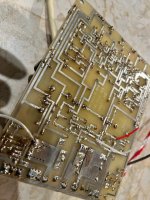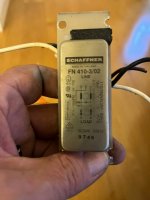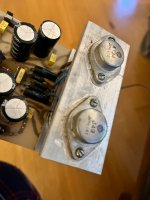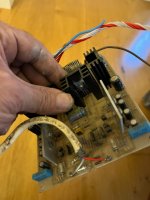@TheFinisher You can mention him in your post with "@" and he will get a notice (just like i did here)but it won’t allow me
+1 good idea@TheFinisher You can mention him in your post with "@" and he will get a notice (just like i did here)
Is there any other info on the stickers besides the manufacturer?Yes there are Sowter and drake transformers
Ok thanks for that@TheFinisher You can mention him in your post with "@" and he will get a notice (just like i did here)
Was the person you bought them from the person who powered them last 10 years ago? If they were working last time i'd be much more inclined to just plug them in. I would probably short the input and connect a dummy load to all outputs the first time, unless i had some disposable speakers. Connect one channel at a time and assuming your house breaker doesn't trip wait and observe (and smell). Like previous posters have written do this in an area you're not very worried about just in case something pops. Main issues assuming it doesn't smoke or smell much is you don't know if the chassis is live (for me personally i don't differentiate between DIY and commercial stuff, i trust everything equally little) and you have no idea of the sensitivity of the amp. So you don't want to electrocute yourself and you don't want to blow your (disposable) speakers.
One thing i always do is wait 30 minutes after powering them down before powering them back up again, just in case there is some NTC in-rush limited involved. Measure if you have any voltage across the dummy load, should be negligible. Never connect or disconnect anything while it's powered up and don't touch any part of the chassis. It's good to use a power extender with a switch on it in case something does happen and you want to cut power fast, you typically don't want to grab the chassis to yank the power cord out.
Those trannies could be output trannies and in that case you definitely do NOT want to send a signal into the amp with nothing connected, that could spell bad news for said trannies.
One thing i always do is wait 30 minutes after powering them down before powering them back up again, just in case there is some NTC in-rush limited involved. Measure if you have any voltage across the dummy load, should be negligible. Never connect or disconnect anything while it's powered up and don't touch any part of the chassis. It's good to use a power extender with a switch on it in case something does happen and you want to cut power fast, you typically don't want to grab the chassis to yank the power cord out.
Those trannies could be output trannies and in that case you definitely do NOT want to send a signal into the amp with nothing connected, that could spell bad news for said trannies.
Preamp? Processor? Missing ICs...The top pcb is a Crimson audio xo 2/3 issue 3
it hurts my stomach...
just the BUZs have more than amply repaid you.
There are many good things in this amp, too bad, we will never know how they sang.
pity, do not kill the BUZ, I could be interested.
just the BUZs have more than amply repaid you.
There are many good things in this amp, too bad, we will never know how they sang.
pity, do not kill the BUZ, I could be interested.
Do you mean the buz900 things?it hurts my stomach...
just the BUZs have more than amply repaid you.
There are many good things in this amp, too bad, we will never know how they sang.
pity, do not kill the BUZ, I could be interested.
Asking about value of the parts is tricky. It is of no value for most of the people, and priceless to some.
+550000Asking about value of the parts is tricky. It is of no value for most of the people, and priceless to some.
I was hoping that someone could use the heat sinks.With that amout of heatsink, one could do nice classA amp for sure.
How about the transformers?
The BUZ things are lateral mosfets. If you dump them, please tell me where 😀
- Home
- Amplifiers
- Solid State
- Help please, powering up a pair of huge diy amps .




